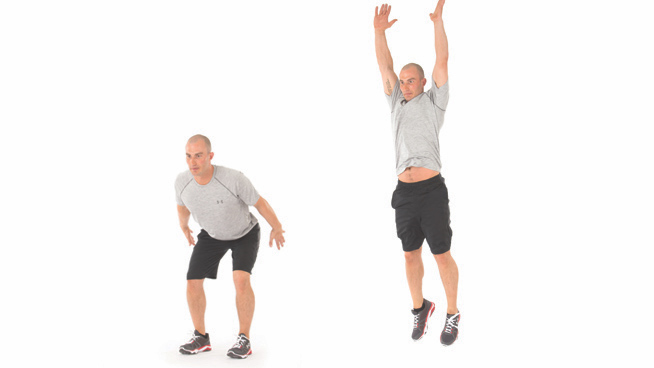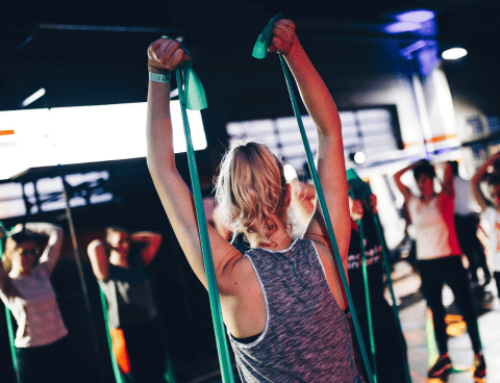Contrast Training 101: Every Athlete Should Know This Technique
What if I told you that you could become stronger, more explosive and leaner, all while spending less time at the gym than you currently do?
Would you be interested?
Enter contrast training. Contrast training is simple: You perform a strength exercise and pair that with an unresisted to lightly-resisted power movement similar to the strength movement you performed. Examples are a Deadlift paired with a Broad Jump, or Bench Press paired with a Medicine Ball Chest Pass.
How Does Contrast Training Work?
Contrast training allows for increased muscle recruitment for your primary movement, allowing you to lift heavier during your sets. When you perform a heavy set of Deadlifts and then perform Broad Jumps, you’re telling your brain to send more help. When you send more support, you’re improving the movement pattern, which will increase strength and allow your body to handle a heavier load.
If contrast training is so great, why not use it all the time?
As human beings, we adapt to whatever is thrown our way. We prefer to hold onto energy and not expend it. So if we keep sending the same signal to our brains, we won’t continue to get the same effect. That’s why programming and planning is an essential aspect of training. We’ll eventually adapt, and if we want to keep making progress in the weight room, we need to send different signals.
The athletes I work with use this phase of contrast training for 3-4 weeks. There’s plenty of factors that go into how long they will stay in this phase. Such as the training age, time of the year, and the goal of the phase. We use contrast training when the athletes have to peak for an event or their season. We also use it when an athlete has been training for a while and needs to break up the training and introduce a new stimulus to adapt to. It also helps to vary the training and keep the athlete interested.
So if an athlete’s season is coming up, or if they have a showcase or combine coming in a couple of weeks, that can be an excellent chance to introduce contrast training.
Can Anyone Use Contrast Training?
Everyone should use contrast training in one form or another. The one big factor that could preclude someone from using contrast training is if they don’t have a solid foundation of strength.
Having a foundation of strength is the most critical part of knowing if you can handle this type of training. For a person to be ready for contrast training, they should train consistently for at least six months and challenge themselves with heavy weights. If they have been doing these two things, they’re ready for the benefits of contrast training.
If you don’t have a great foundation, I suggest you hold off on the contrast training for now and simply focus on working out more consistently and increasing your weights. You need a foundation so you don’t get injured during your contrast training phase. The strength movement is supposed to be heavy; you will be doing 4-5 sets for 2-4 reps of a movement, so the weight has to be challenging. Then, right from the strength movement, you are going to do something explosive. If your body isn’t prepared for those type of rigors, you could hurt yourself.
If you’ve never lifted heavy or haven’t ever done an explosive movement, your body is going to try and protect itself against those actions, which usually ends in an injury.
How do you know if you’re ready for contrast training?
- Make sure you have the proper form with your exercises. If you don’t have someone coaching or showing you, it can be difficult to know how good your form is. Grab a camera and record yourself. If it doesn’t look athletic or you’re second-guessing those reps, you need to lower the weight and clean up your technique.
- Start experimenting with heavier weight. Go into the workout log, look at an exercise and see what the heaviest you’ve ever gone. You can Hex Bar Deadlift 135 for 10 reps? Great! So now start going to 8 reps and maybe adding 20 more pounds. That feels good? Excellent! Try six reps with another 20-30 pounds. Now you’re getting stronger.
- What weights classify as “heavy” for you? To be prepared for contrast training, you should have considerable experience with lifting weights for sets that almost take you to failure, but stop just short of that mark. If you’re completing a set with the feeling you could’ve performed 1 to 2 more reps before failure, that’s good. But if you’re completing a set with the feeling you could’ve performed 3 to 6 more reps before failure, that’s not heavy enough.
- Lastly, make sure you have done some explosive power work. You can simply add jumps, throws, and sprints to the end of your warm-up, or do them on a separate day. The first time you ever attempt a Broad Jump should not be after a heavy Deadlift.
While contrast training can offer great benefits for athletes and fitness-minded people, you need to make sure you have the appropriate foundation of strength and that you’re performing it at the appropriate time. Don’t just jump into contrast training without considering these factors.
How Do I Set Up My Contrast Training?

So, you’re ready to start contrast training. How should you set up your session? The most important factors to a successful contrast training session are:
- Use foundational movements (think Deadlift, Squat, Bench Press and pulling variations) for the heavy lift.
- Avoid using isolation exercises such as Band Bicep Curls as the heavy lift. We’re looking to build large muscle groups, not just grow one muscle.
- Appropriate rest is key. After you complete the strength movement, it should take you no longer than 10-15 seconds to get to the explosive movement. If it does, then you went to heavy on the movement. After you complete the explosive movement, you can rest for 1-3 minutes before staring another set.
- Intent is everything. The explosive movements should be explosive. The jumps shouldn’t look like you’re doing an aerobics class. You should be thinking one jump at a time and trying to touch the sky, not just trying to complete them as fast as possible.
- Before you get to your working sets on the strength movement, make sure you do a couple of ramp-up sets. Let’s say you wanted to Deadlift 225 for the day. You would ramp up by performing 1-3 sets of 2-3 reps at lighter weights just to make sure the movement pattern is primed but not fried. I would use my ramp-up sets as 135-185-205, but you have to find what works best for you.
Let’s say you’ve selected two appropriate moves to pair together in your contrast training and warmed up accordingly. Your program calls for 4×4 of Hex Bar Deadlifts paired with 4×3 of Broad Jumps.
If you perform your first working set of Deadlifts at 225 pounds, you can’t just mindlessly keep that weight the same for every subsequent set. If it felt too easy, add another 10-20 pounds to the bar. If it felt too difficult and you barely eked out the required reps, perhaps bump the weight down. If it felt like the perfect amount of challenge, then you can keep the weight the same.
Once you’ve completed your four sets of contrast training, what should you do for the rest of your session? That all depends on what you’re looking to accomplish and what else you have planned for the week. That’s why having a plan is so important. But I would break down the session with another full body circuit of:
- B1. Single Leg RDL 3-4 sets of 6-8 reps
- B2. Chest Supported Row 3-4 sets 8-10 reps
- B3. Stability Ball Stir the Pot 3-4 sets ten reps/ea side
The reason for including some wiggle room with the number of sets and reps on these exercises is because we have to listen to our body. The goal here is to become stronger and more powerful, not to leave the gym totally exhausted and incapable of performing any more work. Performing a ton of accessory work after your contrast training may not be the best approach. Work smarter, not harder.
The Three Keys of Contrast Training

In review, contrast training can be an excellent way to increase strength, muscle mass and explosive power. But to unlock the full benefits of contrast training, there are three keys you must respect and follow.
1. Make Sure You Build the Foundation First
If you can’t move properly, there’s a chance you’ll hurt yourself during contrast training. Build a proper movement and strength foundation before you try this technique. If you’ve already been training consistently and lifting heavy for several consecutive months, you should be ready to take on constant training (as long as your form is also on point and you have experience with the moves you’ll be using in your contrast training).
2. Move With Intent
Whether it’s the strength or power movement, you need to move with a purpose. You cannot expect to go through the motions with contrast training and still see big results. Move the bar as fast as you can and jump as high or far as you can.
3. Be Smart
Challenge yourself, but stay within yourself. Consistent progress is still progress, so don’t make huge jumps set to set or week to week. Be smart with your weights and be smart with how you program your contrast training. Once you’ve completed a 3- to 4-week phase of contrast training, don’t revisit it too quickly again. I’d suggest waiting at least another eight weeks before beginning another phase of contrast training.
Photo Credit: Neustockimages/iStock.
READ MORE:
RECOMMENDED FOR YOU
MOST POPULAR
Contrast Training 101: Every Athlete Should Know This Technique
What if I told you that you could become stronger, more explosive and leaner, all while spending less time at the gym than you currently do?
Would you be interested?
Enter contrast training. Contrast training is simple: You perform a strength exercise and pair that with an unresisted to lightly-resisted power movement similar to the strength movement you performed. Examples are a Deadlift paired with a Broad Jump, or Bench Press paired with a Medicine Ball Chest Pass.
How Does Contrast Training Work?
Contrast training allows for increased muscle recruitment for your primary movement, allowing you to lift heavier during your sets. When you perform a heavy set of Deadlifts and then perform Broad Jumps, you’re telling your brain to send more help. When you send more support, you’re improving the movement pattern, which will increase strength and allow your body to handle a heavier load.
If contrast training is so great, why not use it all the time?
As human beings, we adapt to whatever is thrown our way. We prefer to hold onto energy and not expend it. So if we keep sending the same signal to our brains, we won’t continue to get the same effect. That’s why programming and planning is an essential aspect of training. We’ll eventually adapt, and if we want to keep making progress in the weight room, we need to send different signals.
The athletes I work with use this phase of contrast training for 3-4 weeks. There’s plenty of factors that go into how long they will stay in this phase. Such as the training age, time of the year, and the goal of the phase. We use contrast training when the athletes have to peak for an event or their season. We also use it when an athlete has been training for a while and needs to break up the training and introduce a new stimulus to adapt to. It also helps to vary the training and keep the athlete interested.
So if an athlete’s season is coming up, or if they have a showcase or combine coming in a couple of weeks, that can be an excellent chance to introduce contrast training.
Can Anyone Use Contrast Training?
Everyone should use contrast training in one form or another. The one big factor that could preclude someone from using contrast training is if they don’t have a solid foundation of strength.
Having a foundation of strength is the most critical part of knowing if you can handle this type of training. For a person to be ready for contrast training, they should train consistently for at least six months and challenge themselves with heavy weights. If they have been doing these two things, they’re ready for the benefits of contrast training.
If you don’t have a great foundation, I suggest you hold off on the contrast training for now and simply focus on working out more consistently and increasing your weights. You need a foundation so you don’t get injured during your contrast training phase. The strength movement is supposed to be heavy; you will be doing 4-5 sets for 2-4 reps of a movement, so the weight has to be challenging. Then, right from the strength movement, you are going to do something explosive. If your body isn’t prepared for those type of rigors, you could hurt yourself.
If you’ve never lifted heavy or haven’t ever done an explosive movement, your body is going to try and protect itself against those actions, which usually ends in an injury.
How do you know if you’re ready for contrast training?
- Make sure you have the proper form with your exercises. If you don’t have someone coaching or showing you, it can be difficult to know how good your form is. Grab a camera and record yourself. If it doesn’t look athletic or you’re second-guessing those reps, you need to lower the weight and clean up your technique.
- Start experimenting with heavier weight. Go into the workout log, look at an exercise and see what the heaviest you’ve ever gone. You can Hex Bar Deadlift 135 for 10 reps? Great! So now start going to 8 reps and maybe adding 20 more pounds. That feels good? Excellent! Try six reps with another 20-30 pounds. Now you’re getting stronger.
- What weights classify as “heavy” for you? To be prepared for contrast training, you should have considerable experience with lifting weights for sets that almost take you to failure, but stop just short of that mark. If you’re completing a set with the feeling you could’ve performed 1 to 2 more reps before failure, that’s good. But if you’re completing a set with the feeling you could’ve performed 3 to 6 more reps before failure, that’s not heavy enough.
- Lastly, make sure you have done some explosive power work. You can simply add jumps, throws, and sprints to the end of your warm-up, or do them on a separate day. The first time you ever attempt a Broad Jump should not be after a heavy Deadlift.
While contrast training can offer great benefits for athletes and fitness-minded people, you need to make sure you have the appropriate foundation of strength and that you’re performing it at the appropriate time. Don’t just jump into contrast training without considering these factors.
How Do I Set Up My Contrast Training?

So, you’re ready to start contrast training. How should you set up your session? The most important factors to a successful contrast training session are:
- Use foundational movements (think Deadlift, Squat, Bench Press and pulling variations) for the heavy lift.
- Avoid using isolation exercises such as Band Bicep Curls as the heavy lift. We’re looking to build large muscle groups, not just grow one muscle.
- Appropriate rest is key. After you complete the strength movement, it should take you no longer than 10-15 seconds to get to the explosive movement. If it does, then you went to heavy on the movement. After you complete the explosive movement, you can rest for 1-3 minutes before staring another set.
- Intent is everything. The explosive movements should be explosive. The jumps shouldn’t look like you’re doing an aerobics class. You should be thinking one jump at a time and trying to touch the sky, not just trying to complete them as fast as possible.
- Before you get to your working sets on the strength movement, make sure you do a couple of ramp-up sets. Let’s say you wanted to Deadlift 225 for the day. You would ramp up by performing 1-3 sets of 2-3 reps at lighter weights just to make sure the movement pattern is primed but not fried. I would use my ramp-up sets as 135-185-205, but you have to find what works best for you.
Let’s say you’ve selected two appropriate moves to pair together in your contrast training and warmed up accordingly. Your program calls for 4×4 of Hex Bar Deadlifts paired with 4×3 of Broad Jumps.
If you perform your first working set of Deadlifts at 225 pounds, you can’t just mindlessly keep that weight the same for every subsequent set. If it felt too easy, add another 10-20 pounds to the bar. If it felt too difficult and you barely eked out the required reps, perhaps bump the weight down. If it felt like the perfect amount of challenge, then you can keep the weight the same.
Once you’ve completed your four sets of contrast training, what should you do for the rest of your session? That all depends on what you’re looking to accomplish and what else you have planned for the week. That’s why having a plan is so important. But I would break down the session with another full body circuit of:
- B1. Single Leg RDL 3-4 sets of 6-8 reps
- B2. Chest Supported Row 3-4 sets 8-10 reps
- B3. Stability Ball Stir the Pot 3-4 sets ten reps/ea side
The reason for including some wiggle room with the number of sets and reps on these exercises is because we have to listen to our body. The goal here is to become stronger and more powerful, not to leave the gym totally exhausted and incapable of performing any more work. Performing a ton of accessory work after your contrast training may not be the best approach. Work smarter, not harder.
The Three Keys of Contrast Training

In review, contrast training can be an excellent way to increase strength, muscle mass and explosive power. But to unlock the full benefits of contrast training, there are three keys you must respect and follow.
1. Make Sure You Build the Foundation First
If you can’t move properly, there’s a chance you’ll hurt yourself during contrast training. Build a proper movement and strength foundation before you try this technique. If you’ve already been training consistently and lifting heavy for several consecutive months, you should be ready to take on constant training (as long as your form is also on point and you have experience with the moves you’ll be using in your contrast training).
2. Move With Intent
Whether it’s the strength or power movement, you need to move with a purpose. You cannot expect to go through the motions with contrast training and still see big results. Move the bar as fast as you can and jump as high or far as you can.
3. Be Smart
Challenge yourself, but stay within yourself. Consistent progress is still progress, so don’t make huge jumps set to set or week to week. Be smart with your weights and be smart with how you program your contrast training. Once you’ve completed a 3- to 4-week phase of contrast training, don’t revisit it too quickly again. I’d suggest waiting at least another eight weeks before beginning another phase of contrast training.
Photo Credit: Neustockimages/iStock.
READ MORE:












